目录
- 本文章主要记录了自己手动标注数据集并将其训练,测试的过程。
环境搭建
Python>=3.8.0
强烈建议装CUDA,相关安装请查阅百度
git clone https://github.com/ultralytics/yolov5 # clone
cd yolov5
pip install -r requirements.txt # install当然你也可以去官方下载压缩包
克隆/解压缩包成功后得到这样一个文件夹

有关yolov5的详细安装请看我的另一篇文章,这里就不赘述了。
如何安装yolov5 这里有详细讲解。
模型训练前的准备
创建相关文件夹
首先打开yolov5文件夹,新建一个 VOCdata 文件夹
 在VOCdata文件夹中创建两个文件夹,一个名为Annotations,一个名为images
在VOCdata文件夹中创建两个文件夹,一个名为Annotations,一个名为images

将你的图片保存到images文件夹中,记得图片不能带有中文,特殊符号等等最好就是数字排序,1,2,3,4这种。
安装图片打标签工具——labelimg
- windows+conda安装
打开anaconda prompt
cd到你想克隆库的地方,输入:
git clone https://github.com/HumanSignal/labelImg.git
cd labelimg
conda install pyqt=5
conda install -c anaconda lxml
pyrcc5 -o libs/resources.py resources.qrc
python labelImg.py- cmd安装
pip3 install labelImg
labelImg- .exe应用程序
我上传到百度网盘,需要自取
链接:https://pan.baidu.com/s/1T2R68E3vYp_iKCPcMpNG1Q
提取码:lpnb
直接双击.exe文件就能运行
使用labelimg给图片打标签
本文选择默认的VOC格式保存标签,yolo_txt格式后面会讲
首先运行labelimg
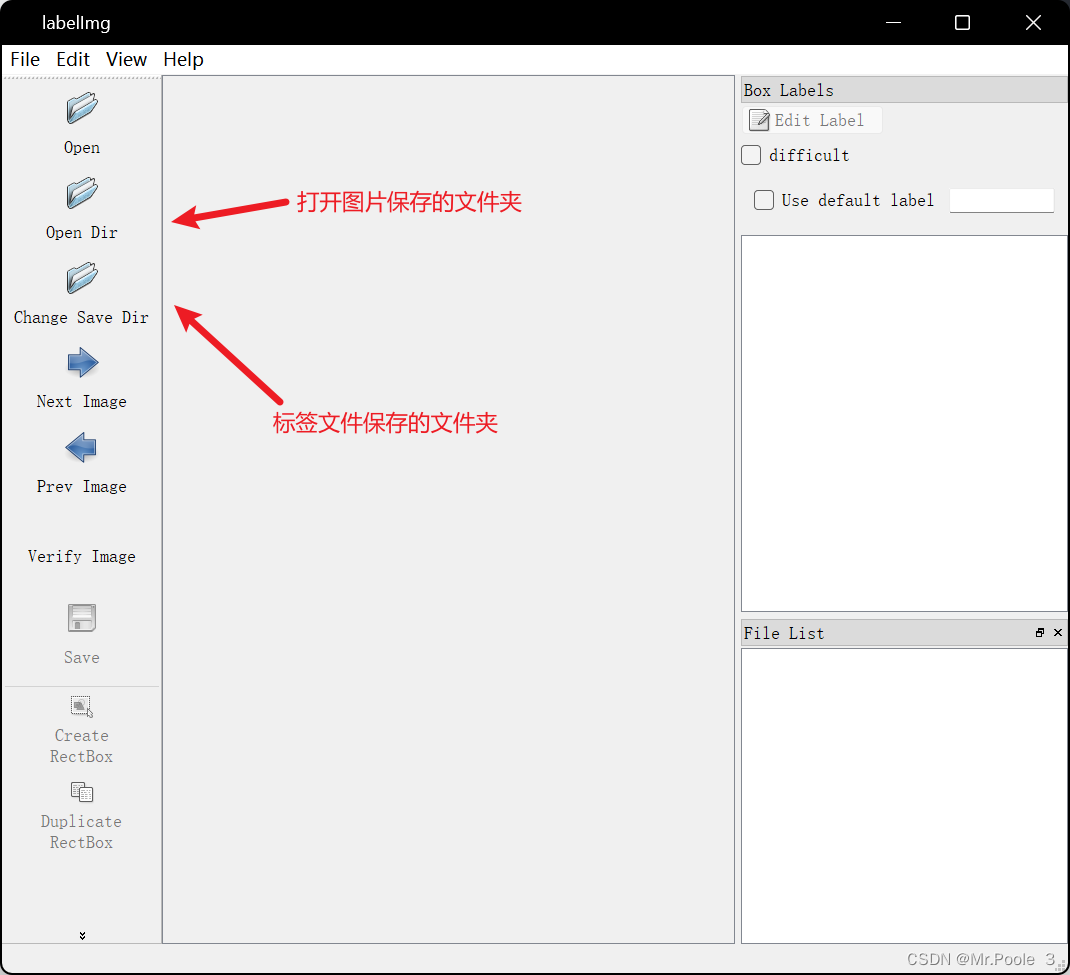
打开View,点击auto saving,这样就会自动保存标签文件。
点击change save dir,选择刚刚创建的Annotations文件夹
点击open dir 打开images文件夹将图片导入
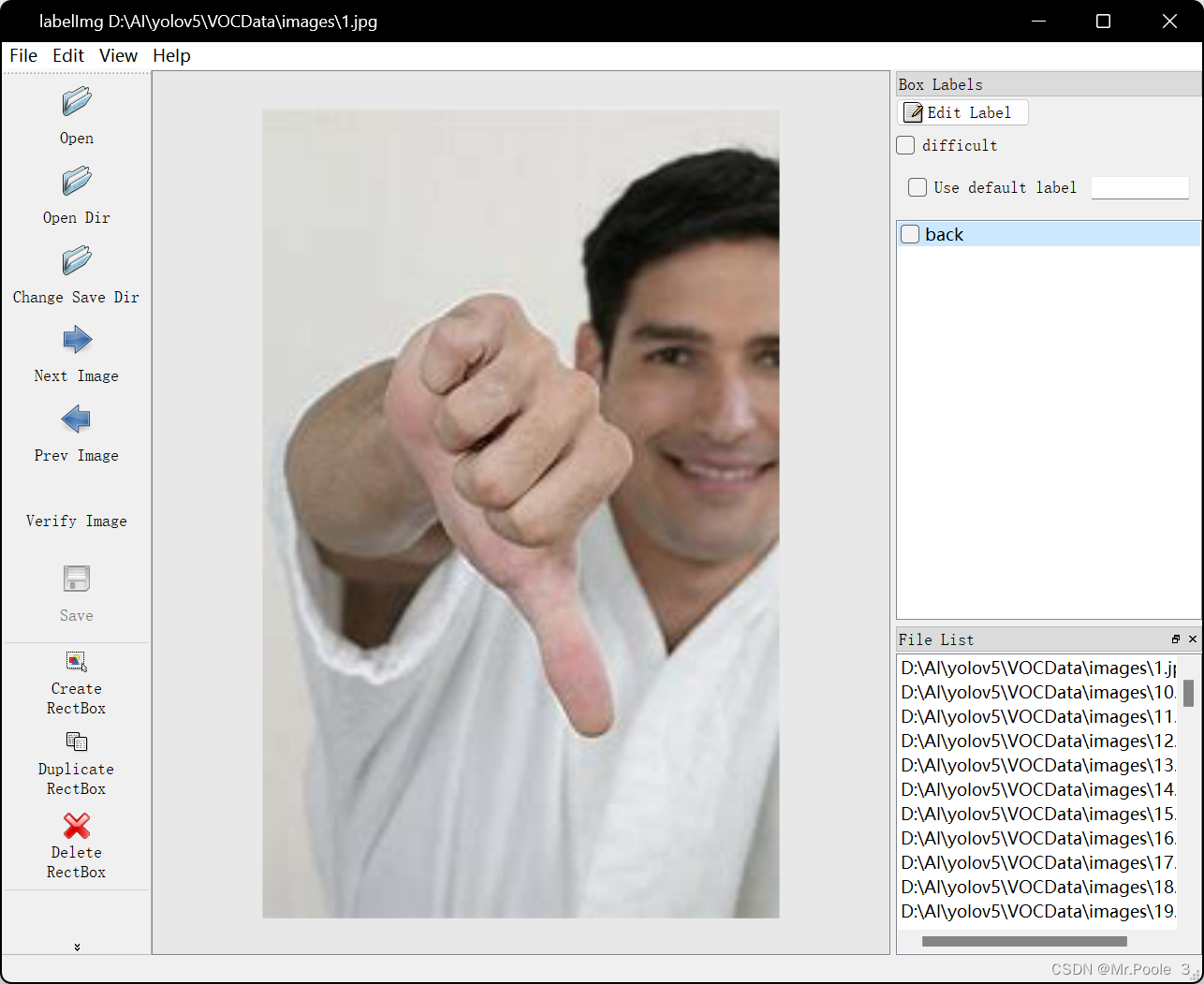
常用快捷键介绍:
- d:下一张图片
- a:上一张图片
- w:绘制标签框
点击 create rectbox 绘制标签框
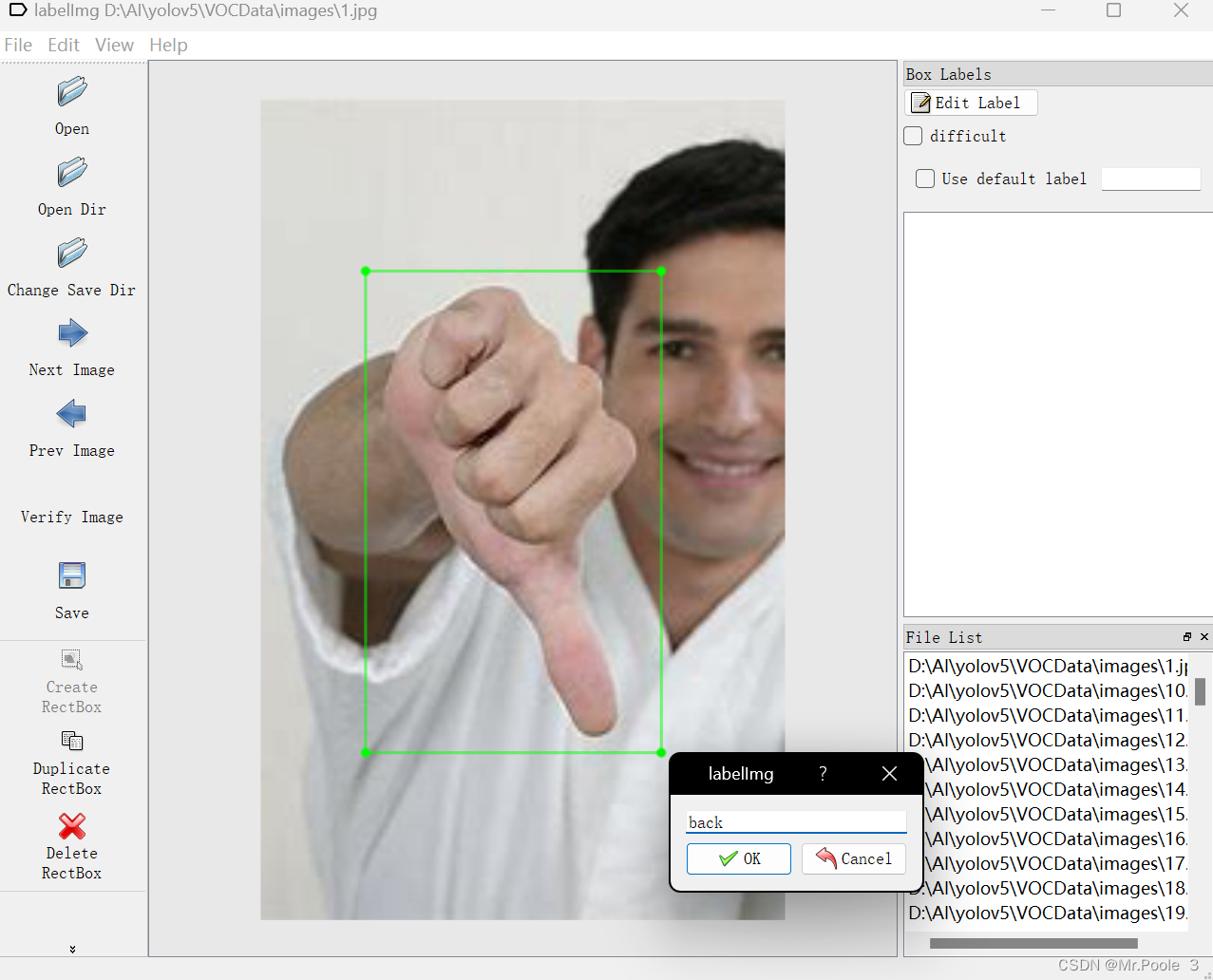
框内输入你想命名的标签名称,这里我给他命名为 back
全部打好标签后,在我们Annotations文件夹里面就会有标签文件
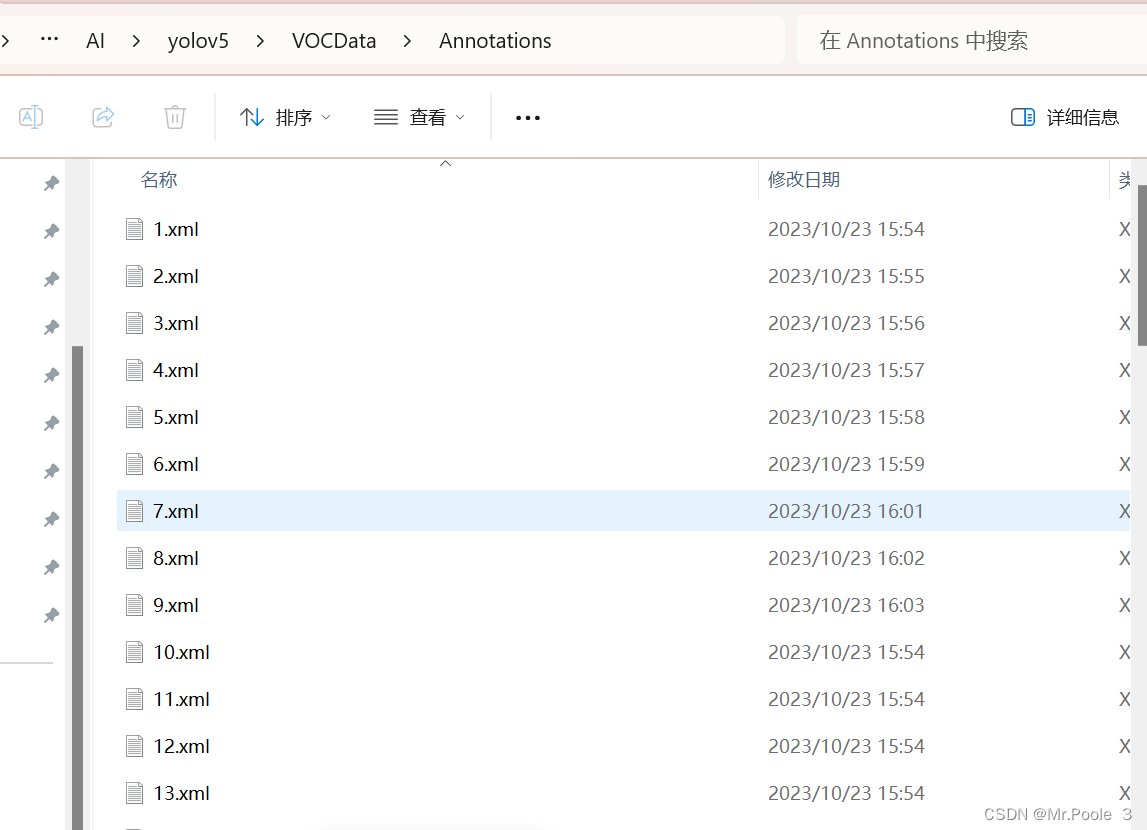
划分数据集
在VOCdata文件夹内创建 divide.py文件,打开,代码如下:
# coding:utf-8
import os
import random
import argparse
parser = argparse.ArgumentParser()
#xml文件的地址,根据自己的数据进行修改 xml一般存放在Annotations下
parser.add_argument('--xml_path', default='Annotations', type=str, help='input xml label path')
#数据集的划分,地址选择自己数据下的ImageSets/Main
parser.add_argument('--txt_path', default='ImageSets/Main', type=str, help='output txt label path')
opt = parser.parse_args()
trainval_percent = 1.0 # 训练集和验证集所占比例。 这里没有划分测试集
train_percent = 0.9 # 训练集所占比例,可自己进行调整
xmlfilepath = opt.xml_path
txtsavepath = opt.txt_path
total_xml = os.listdir(xmlfilepath)
if not os.path.exists(txtsavepath):
os.makedirs(txtsavepath)
num = len(total_xml)
list_index = range(num)
tv = int(num * trainval_percent)
tr = int(tv * train_percent)
trainval = random.sample(list_index, tv)
train = random.sample(trainval, tr)
file_trainval = open(txtsavepath + '/trainval.txt', 'w')
file_test = open(txtsavepath + '/test.txt', 'w')
file_train = open(txtsavepath + '/train.txt', 'w')
file_val = open(txtsavepath + '/val.txt', 'w')
for i in list_index:
name = total_xml[i][:-4] + '\n'
if i in trainval:
file_trainval.write(name)
if i in train:
file_train.write(name)
else:
file_val.write(name)
else:
file_test.write(name)
file_trainval.close()
file_train.close()
file_val.close()
file_test.close()运行完毕后文件夹内会生成 ImagesSets\Main 文件夹,里面存放了测试集,训练集,验证集,以及图片的名称。
配置文件修改
我们需要将VOC文件转化为yolo_txt的格式
在VOCData目录下创建 voc_to_yolotxt.py,打开,代码如下:
import xml.etree.ElementTree as ET
import os
from os import getcwd
sets = ['train', 'val', 'test']
classes = ["move","back"] # 改成自己的类别,我的是move和back,你改成你自己定义的标签名
abs_path = os.getcwd()
print(abs_path)
def convert(size, box):
dw = 1. / (size[0])
dh = 1. / (size[1])
x = (box[0] + box[1]) / 2.0 - 1
y = (box[2] + box[3]) / 2.0 - 1
w = box[1] - box[0]
h = box[3] - box[2]
x = x * dw
w = w * dw
y = y * dh
h = h * dh
return x, y, w, h
def convert_annotation(image_id):
in_file = open('D:/AI/yolov5/VOCData/Annotations/%s.xml' % (image_id), encoding='UTF-8')
out_file = open('D:/AI/yolov5/VOCData/labels/%s.txt' % (image_id), 'w')
tree = ET.parse(in_file)
root = tree.getroot()
size = root.find('size')
w = int(size.find('width').text)
h = int(size.find('height').text)
for obj in root.iter('object'):
difficult = obj.find('difficult').text
# difficult = obj.find('Difficult').text
cls = obj.find('name').text
if cls not in classes or int(difficult) == 1:
continue
cls_id = classes.index(cls)
xmlbox = obj.find('bndbox')
b = (float(xmlbox.find('xmin').text), float(xmlbox.find('xmax').text), float(xmlbox.find('ymin').text),
float(xmlbox.find('ymax').text))
b1, b2, b3, b4 = b
# 标注越界修正
if b2 > w:
b2 = w
if b4 > h:
b4 = h
b = (b1, b2, b3, b4)
bb = convert((w, h), b)
out_file.write(str(cls_id) + " " + " ".join([str(a) for a in bb]) + '\n')
wd = getcwd()
for image_set in sets:
if not os.path.exists('D:/AI/yolov5/VOCData/labels/'):
os.makedirs('D:/AI/yolov5/VOCData/labels/')
image_ids = open('D:/AI/yolov5/VOCData/ImageSets/Main/%s.txt' % (image_set)).read().strip().split()
if not os.path.exists('D:/AI/yolov5/VOCData/dataSet_path/'):
os.makedirs('D:/AI/yolov5/VOCData/dataSet_path/')
list_file = open('dataSet_path/%s.txt' % (image_set), 'w')
for image_id in image_ids:
list_file.write('D:/AI/yolov5/VOCData/images/%s.jpg\n' % (image_id))
convert_annotation(image_id)
list_file.close()注意:代码中有我自己的文件路径,因此你需要根据你的情况修改自己的文件路径
运行后会生成如下 labels 文件夹和 dataSet_path 文件夹
在label文件夹里面就是保存的我们yolo.txt的文件
文件里面的格式为:class, x_center, y_center, width, height
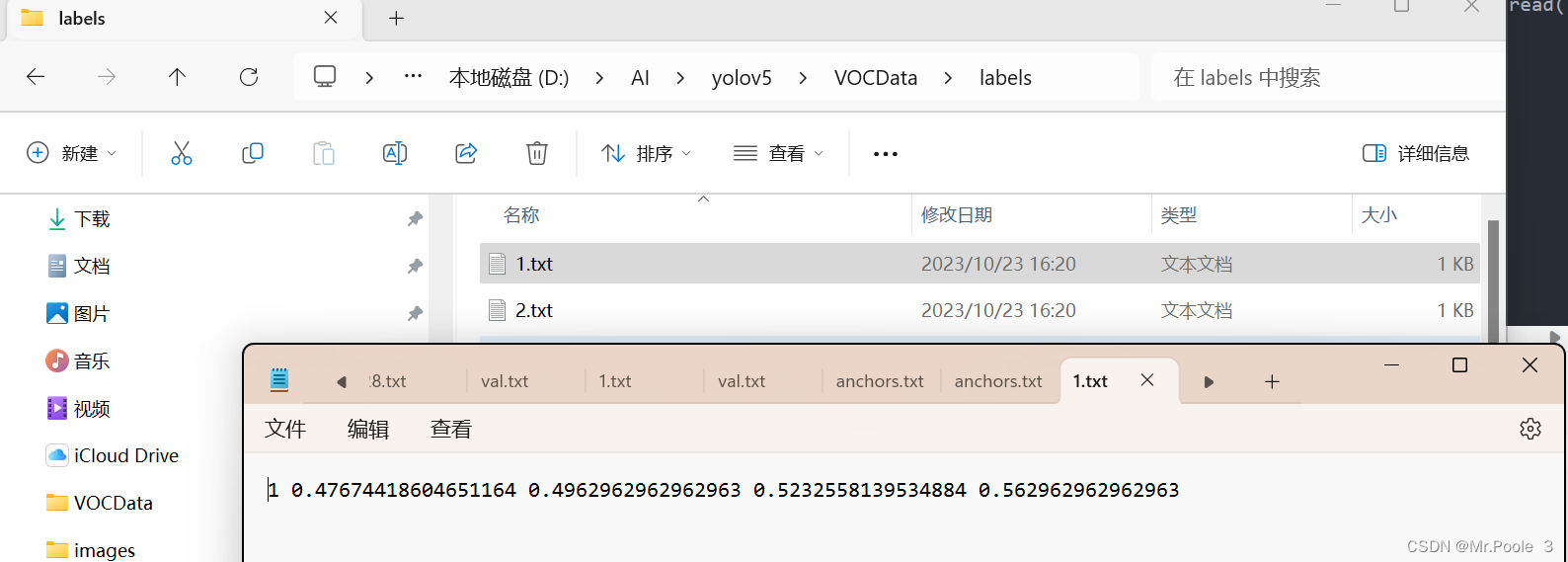
在 yolov5 目录下的 data 文件夹下 新建一个 myvoc.yaml文件,打开输入:
train: D:\Testcode\yolov5-5.0\VOCData\dataSet_path\train.txt #改为你自己的路径
val: D:\Testcode\yolov5-5.0\VOCData\dataSet_path\val.txt #改为你自己的路径
# 你有几个标签就改为几,比如我有move和back,就写 2
nc: 1
# 你的标签名
names: ["move","back"]聚类获得先验框
在VOCdata目录下创建程序两个程序
kmeans.py 以及 clauculate_anchors.py
打开kmeans.py(不要运行),代码如下:
import numpy as np
def iou(box, clusters):
"""
Calculates the Intersection over Union (IoU) between a box and k clusters.
:param box: tuple or array, shifted to the origin (i. e. width and height)
:param clusters: numpy array of shape (k, 2) where k is the number of clusters
:return: numpy array of shape (k, 0) where k is the number of clusters
"""
x = np.minimum(clusters[:, 0], box[0])
y = np.minimum(clusters[:, 1], box[1])
if np.count_nonzero(x == 0) > 0 or np.count_nonzero(y == 0) > 0:
raise ValueError("Box has no area") # 如果报这个错,可以把这行改成pass即可
intersection = x * y
box_area = box[0] * box[1]
cluster_area = clusters[:, 0] * clusters[:, 1]
iou_ = intersection / (box_area + cluster_area - intersection)
return iou_
def avg_iou(boxes, clusters):
"""
Calculates the average Intersection over Union (IoU) between a numpy array of boxes and k clusters.
:param boxes: numpy array of shape (r, 2), where r is the number of rows
:param clusters: numpy array of shape (k, 2) where k is the number of clusters
:return: average IoU as a single float
"""
return np.mean([np.max(iou(boxes[i], clusters)) for i in range(boxes.shape[0])])
def translate_boxes(boxes):
"""
Translates all the boxes to the origin.
:param boxes: numpy array of shape (r, 4)
:return: numpy array of shape (r, 2)
"""
new_boxes = boxes.copy()
for row in range(new_boxes.shape[0]):
new_boxes[row][2] = np.abs(new_boxes[row][2] - new_boxes[row][0])
new_boxes[row][3] = np.abs(new_boxes[row][3] - new_boxes[row][1])
return np.delete(new_boxes, [0, 1], axis=1)
def kmeans(boxes, k, dist=np.median):
"""
Calculates k-means clustering with the Intersection over Union (IoU) metric.
:param boxes: numpy array of shape (r, 2), where r is the number of rows
:param k: number of clusters
:param dist: distance function
:return: numpy array of shape (k, 2)
"""
rows = boxes.shape[0]
distances = np.empty((rows, k))
last_clusters = np.zeros((rows,))
np.random.seed()
# the Forgy method will fail if the whole array contains the same rows
clusters = boxes[np.random.choice(rows, k, replace=False)]
while True:
for row in range(rows):
distances[row] = 1 - iou(boxes[row], clusters)
nearest_clusters = np.argmin(distances, axis=1)
if (last_clusters == nearest_clusters).all():
break
for cluster in range(k):
clusters[cluster] = dist(boxes[nearest_clusters == cluster], axis=0)
last_clusters = nearest_clusters
return clusters
if __name__ == '__main__':
a = np.array([[1, 2, 3, 4], [5, 7, 6, 8]])
print(translate_boxes(a))打开clauculate_anchors.py,代码如下:
记得修改里面的路径以及第16 行的标注类别名称
import os
import numpy as np
import xml.etree.cElementTree as et
from kmeans import kmeans, avg_iou
FILE_ROOT = "D:/AI/yolov5/VOCData/" # 根路径
ANNOTATION_ROOT = "Annotations" # 数据集标签文件夹路径
ANNOTATION_PATH = FILE_ROOT + ANNOTATION_ROOT
ANCHORS_TXT_PATH = "D:/AI/yolov5/VOCData/anchors.txt" # anchors文件保存位置
CLUSTERS = 9
CLASS_NAMES = ['move','back'] # 类别名称
def load_data(anno_dir, class_names):
xml_names = os.listdir(anno_dir)
boxes = []
for xml_name in xml_names:
xml_pth = os.path.join(anno_dir, xml_name)
tree = et.parse(xml_pth)
width = float(tree.findtext("./size/width"))
height = float(tree.findtext("./size/height"))
for obj in tree.findall("./object"):
cls_name = obj.findtext("name")
if cls_name in class_names:
xmin = float(obj.findtext("bndbox/xmin")) / width
ymin = float(obj.findtext("bndbox/ymin")) / height
xmax = float(obj.findtext("bndbox/xmax")) / width
ymax = float(obj.findtext("bndbox/ymax")) / height
box = [xmax - xmin, ymax - ymin]
boxes.append(box)
else:
continue
return np.array(boxes)
if __name__ == '__main__':
anchors_txt = open(ANCHORS_TXT_PATH, "w")
train_boxes = load_data(ANNOTATION_PATH, CLASS_NAMES)
count = 1
best_accuracy = 0
best_anchors = []
best_ratios = []
for i in range(10): ##### 可以修改,不要太大,否则时间很长
anchors_tmp = []
clusters = kmeans(train_boxes, k=CLUSTERS)
idx = clusters[:, 0].argsort()
clusters = clusters[idx]
# print(clusters)
for j in range(CLUSTERS):
anchor = [round(clusters[j][0] * 640, 2), round(clusters[j][1] * 640, 2)]
anchors_tmp.append(anchor)
print(f"Anchors:{anchor}")
temp_accuracy = avg_iou(train_boxes, clusters) * 100
print("Train_Accuracy:{:.2f}%".format(temp_accuracy))
ratios = np.around(clusters[:, 0] / clusters[:, 1], decimals=2).tolist()
ratios.sort()
print("Ratios:{}".format(ratios))
print(20 * "*" + " {} ".format(count) + 20 * "*")
count += 1
if temp_accuracy > best_accuracy:
best_accuracy = temp_accuracy
best_anchors = anchors_tmp
best_ratios = ratios
anchors_txt.write("Best Accuracy = " + str(round(best_accuracy, 2)) + '%' + "\r\n")
anchors_txt.write("Best Anchors = " + str(best_anchors) + "\r\n")
anchors_txt.write("Best Ratios = " + str(best_ratios))
anchors_txt.close()运行clauculate_anchors.py后,会生成anchors.txt文件。

修改模型配置文件
选择一个模型,在yolov5目录下的model文件夹下是模型的配置文件,有n、s、m、l、x版本,逐渐增大(随着架构的增大,训练时间也是逐渐增大)。你也可以自己去github上找其他的模型,本文采用的是yolov5m
在yolov5\models文件夹内打开 yolov5m.yaml
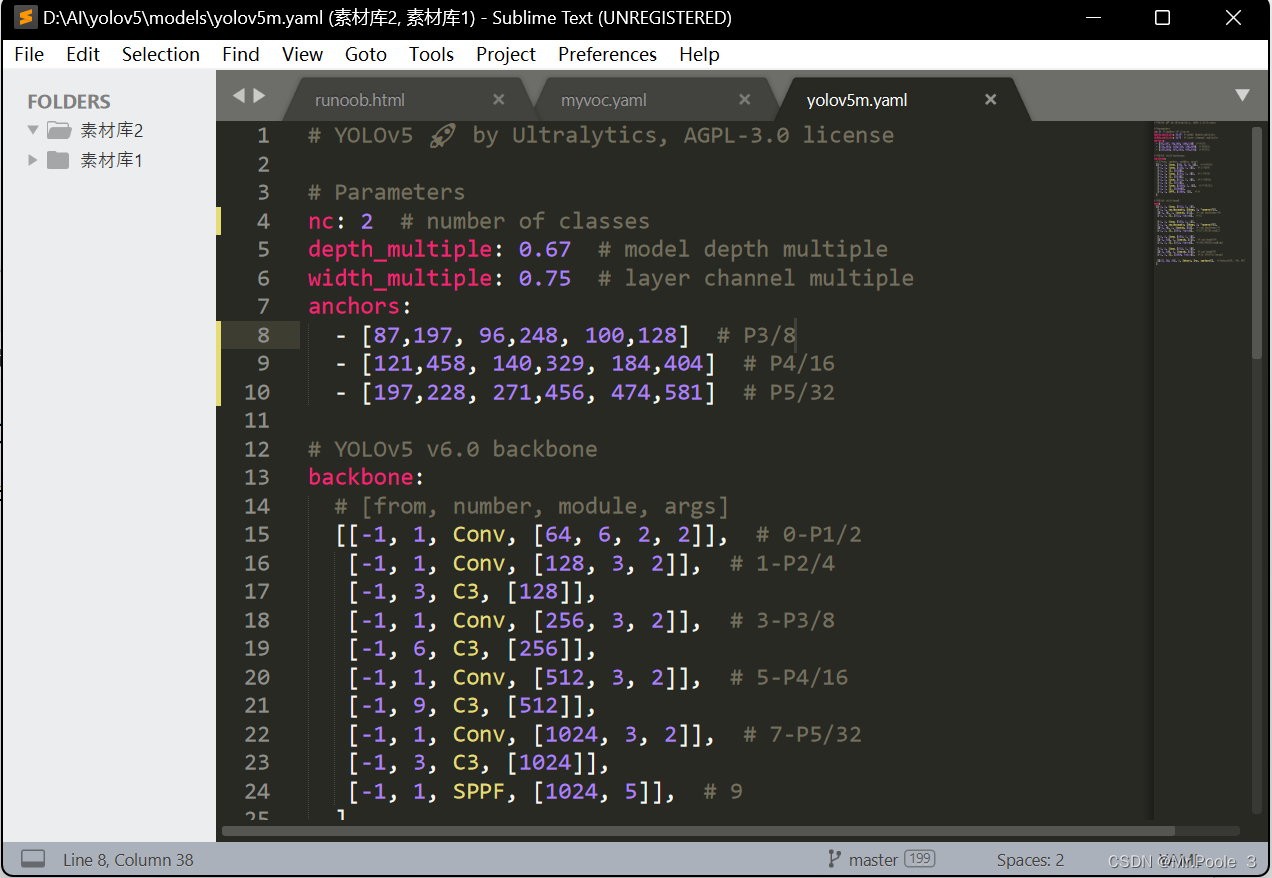
修改nc: 2 #你的标签数量
然后就是打开刚才的anchors.txt,一一对应 yolov5m.yaml里面的anchors
根据 anchors.txt 中的 Best Anchors 修改,需要取整 四舍五入就行
如图一一对应就行
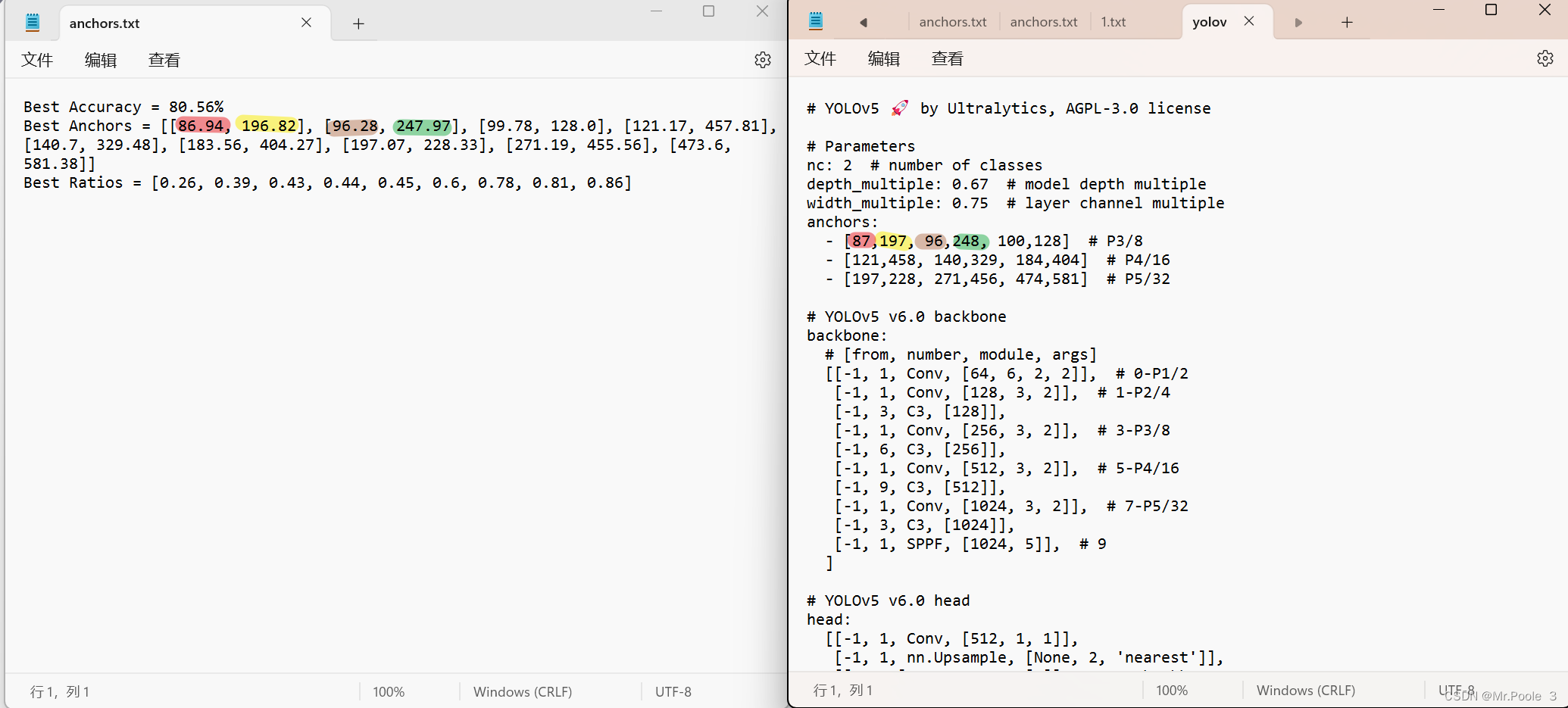
模型训练
cmd,进入你的虚拟环境
进入yolov5的目录

训练代码
weights:权重文件路径
cfg:存储模型结构的配置文件
data:存储训练、测试数据的文件
epochs:指的就是训练过程中整个数据集将被迭代多少次
batch-size:一次看完多少张图片才进行权重更新,梯度下降的mini-batch
img-size:输入图片宽高
device:cuda device 0 这里我选择使用device0即为GPU训练
python train.py --weights weights/yolov5s.pt --cfg models/yolov5s.yaml --data data/myvoc.yaml --epoch 233 --batch-size 8 --img 640 --device 0
回车开始训练!!!!!
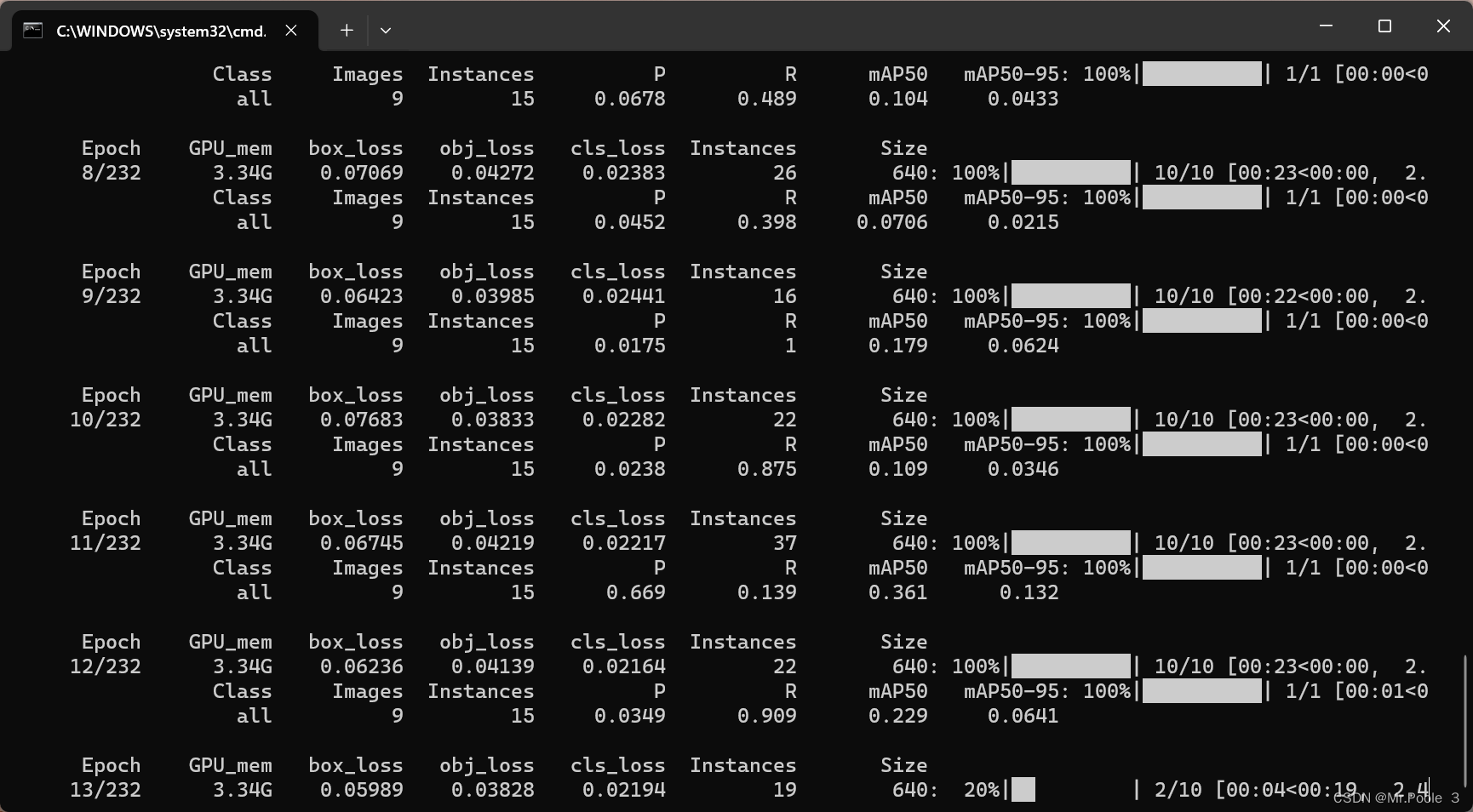
训练好的模型best.pt会被保存在 yolov5 目录下的 runs/train/weights/exp xx下(具体上面会显示)
我用了大概60张图片训练了232次,用时1小时32分钟(rtx3060 laptop)
使用自己的模型
训练好模型后,复制best.pt粘贴到yolov5目录中
打开detect.py,在weights那一排中修改为你的模型,下一排default设置为'0'(调用笔记本摄像头)

修改后直接运行,这样就大功告成了!!!!!!!!!!!!!
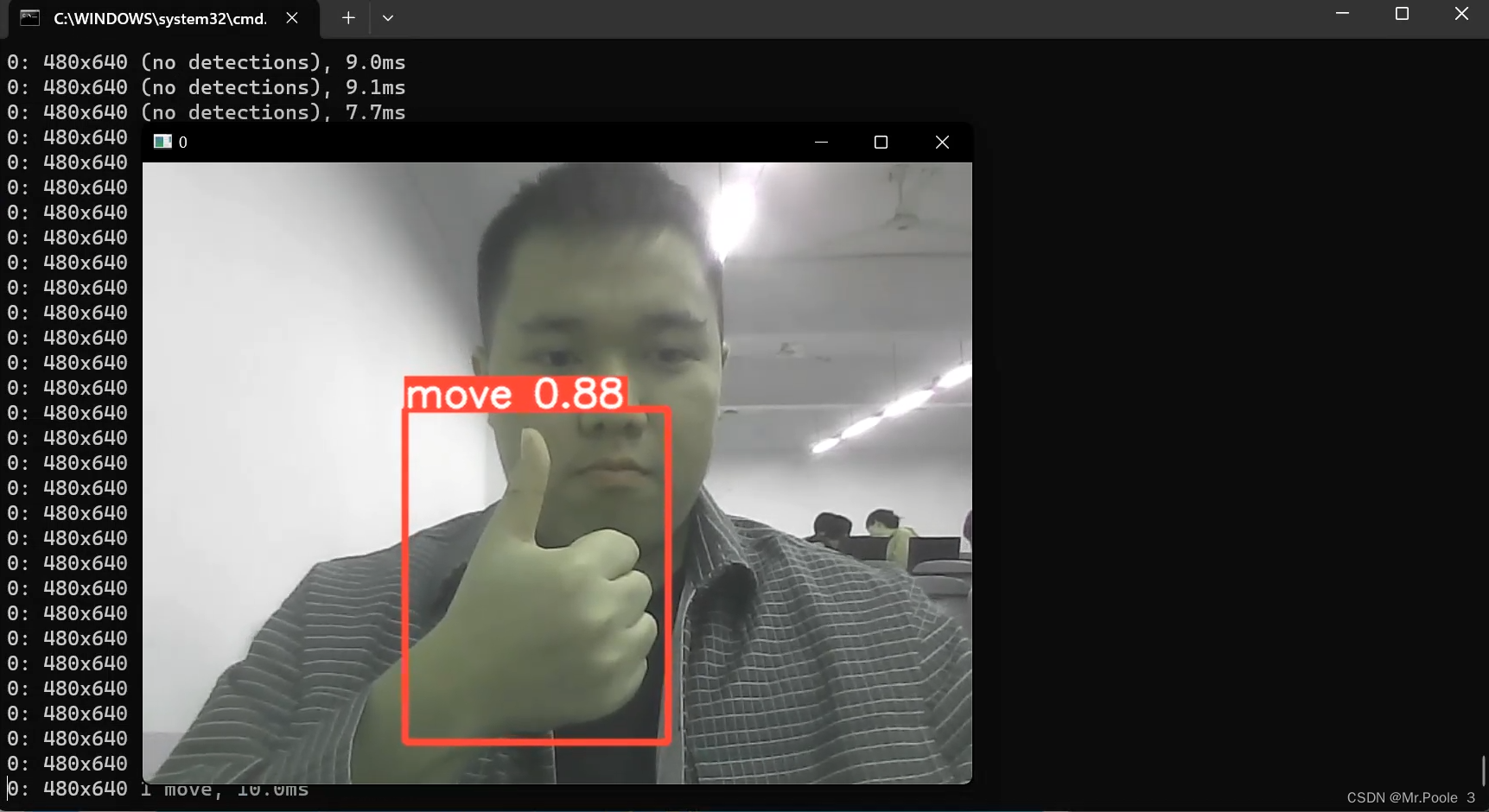
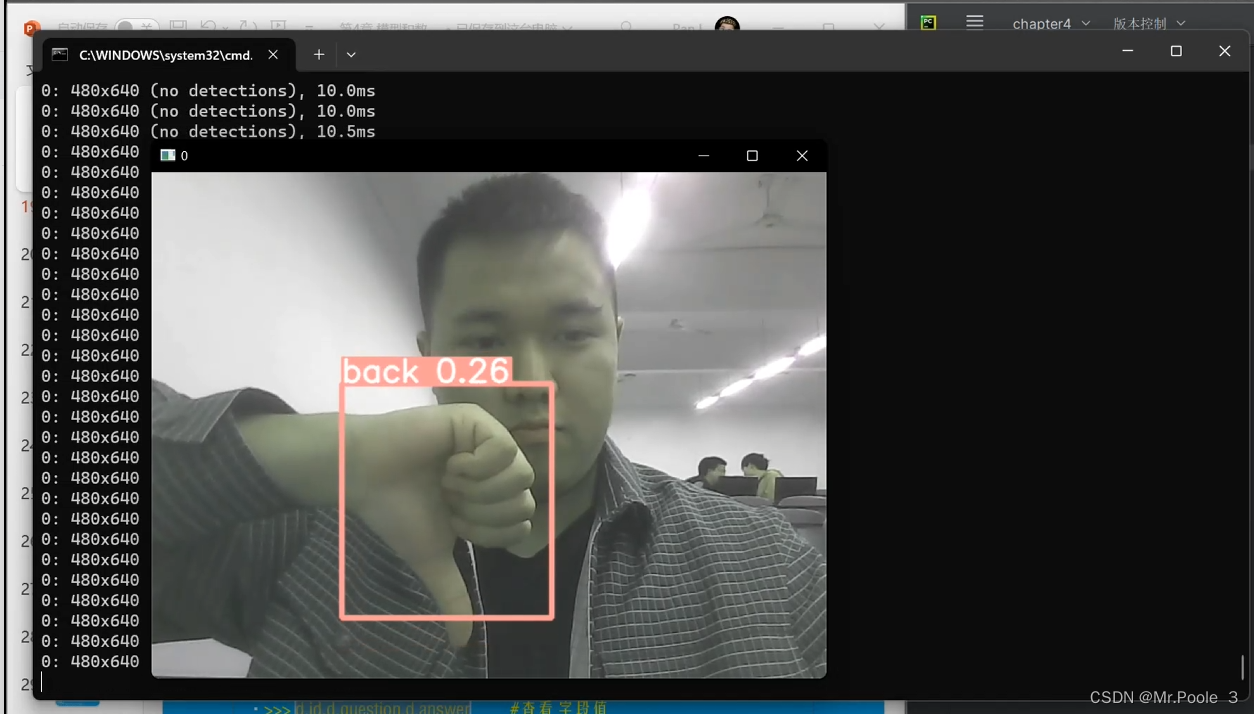






















 8071
8071











 被折叠的 条评论
为什么被折叠?
被折叠的 条评论
为什么被折叠?








